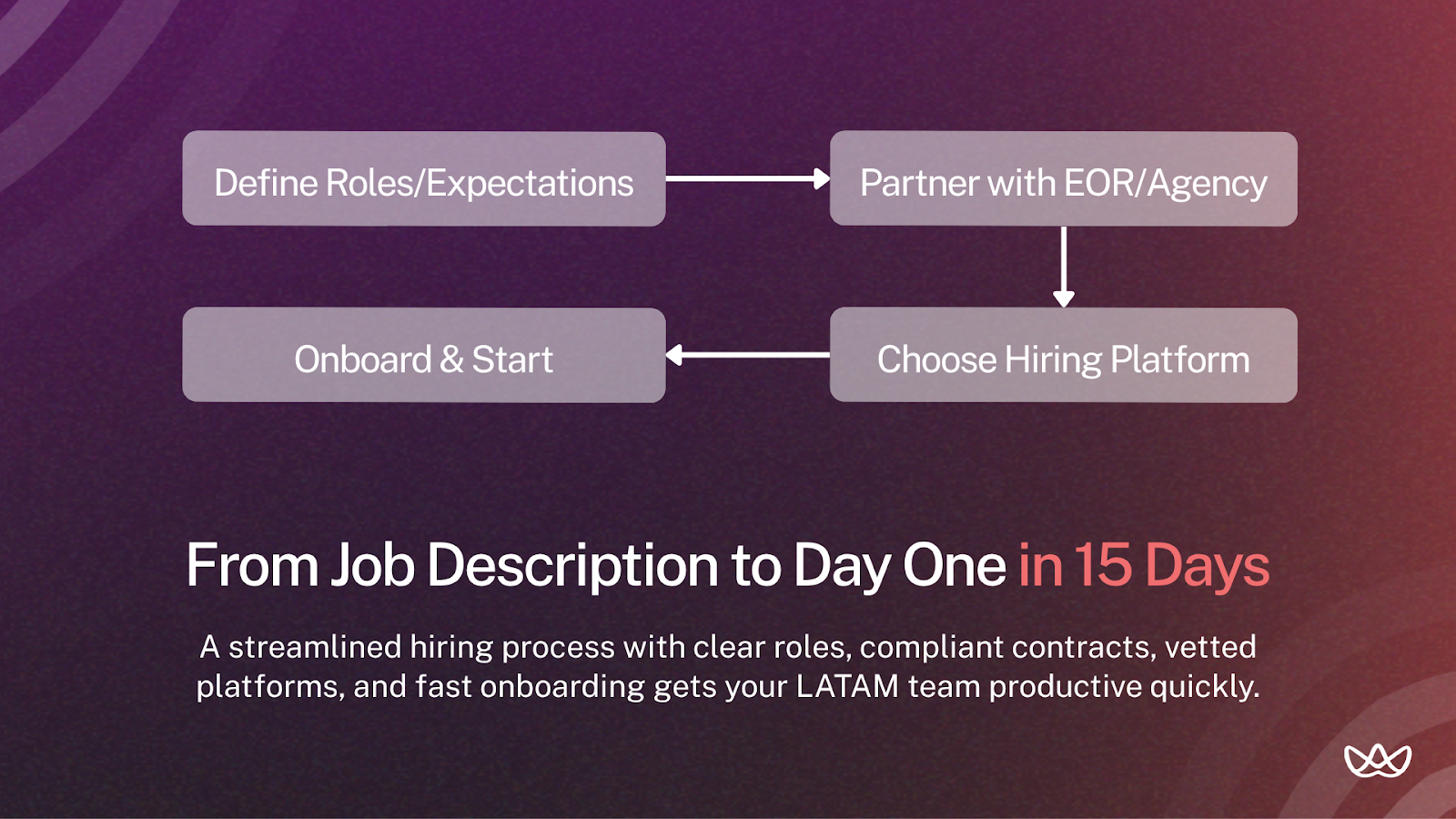In 2025, Latin America has become one of the fastest-growing regions for remote hiring. The math works simple for U.S. companies: skilled, bilingual professionals, strong cultural alignment, and time-zone overlap that lets teams work together in real time.
They show up in how teams communicate, how fast projects move, and how budgets stretch further without compromising on quality.
And with Floowi, hiring remote talent in LATAM is more efficient, with every candidate vetted, compliant, and ready to start within days.
Let’s explore why LATAM has become a key source of remote talent, which roles are in demand, and how to hire and manage teams effectively.
LATAM Remote Hiring Snapshot (2025)
LATAM makes it easy to work in real time with U.S. teams, with strong English skills and big cost savings. You can scale affordably while tapping into plenty of talent in marketing, tech, and sales.
Why U.S. Companies Are Turning to LATAM for Remote Talent
1. Time Zone Compatibility for Real-Time Collaboration
LATAM professionals overlap with U.S. working hours, which speeds up feedback and keeps projects moving. When a designer in Colombia or a marketing lead in Mexico can join a 2 PM EST meeting without staying late, tasks get resolved faster and decisions happen in real time.

This overlap gives teams what engineers call "synchronous bandwidth" - you can get answers the same day rather than waiting for delayed responses across distant time zones.
2. Cultural Alignment and Effective Communication
Shared work styles and cultural familiarity make collaboration smoother. Many LATAM professionals understand U.S. business practices and communicate in ways that feel natural to U.S. teams.
For example, a Mexican SDR quickly understands American sales cues, and a Colombian designer responds to feedback in a way that matches U.S. expectations. These shared cues reduce friction and save time.
3. High-Quality, Cost-Effective Workforce
LATAM talent is skilled and costs up to 60% less than U.S. equivalents. A full-time marketing specialist, UX designer, or operations manager in LATAM earns around $2,200-$3,000 per month, compared to $5,000-$6,500 in the U.S.
This difference reflects regional cost of living rather than lower quality. A senior UX designer in Bogotá or a marketing manager in Mexico City manages campaigns, client projects, and team workflows just like their U.S. counterparts, but at a lower monthly cost.
4. Expanding Talent Pool with Specialized Skills
Marketing, design, and ops professionals in LATAM often have international experience. Colombian marketing teams, Argentine designers, and Mexican operations managers have worked with U.S. clients for years, familiar with the tools, processes, and expectations of remote work.
Specialization runs deep. Many have certifications, agency experience, or track records of managing cross-border projects successfully.
5. Regulatory and Infrastructure Advantages
Reliable internet and modern infrastructure make remote work smooth. Major cities have high-speed fiber, co-working spaces with backup power, and strong mobile networks.
Labor laws in countries like Mexico and Colombia now support remote arrangements, and using an Employer of Record (EOR) ensures compliance even if you’re not familiar with local regulations.
Top Countries for Remote Talent in LATAM
1. Colombia: Emerging Talent Hub
Colombia is strong in marketing, design, and B2B sales roles, with many professionals fluent in English. Medellín and Bogotá have grown into hubs for digital agencies and startups.
Professionals in Colombia often combine creative thinking with solid process skills. Many have experience serving U.S. clients through local agencies before taking on direct remote roles.
2. Mexico: Proximity and Depth of Skills
Mexico offers time zone alignment with the U.S., which makes meetings and collaboration easier, especially for West Coast teams. Someone in Mexico City works the same hours as Denver or Austin.
Northern states near the U.S. border have particularly strong English skills due to business ties. With the largest population in LATAM, Mexico provides a wide pool of marketing, design, and operations professionals.
3. Costa Rica: Specialized and Premium Talent
Costa Rica has highly educated professionals in marketing, operations, and project management. Many have experience with multinational companies, giving them familiarity with enterprise tools and processes.
Salaries are slightly higher than other LATAM countries but still offer 50%+ savings compared to U.S. rates. You often find talent with experience at companies like Intel, Amazon, or HP before going independent.
4. Brazil and Other Fast-Growing Markets
Brazil continues to grow in creative and operations roles, while Argentina, Chile, and Peru provide reliable marketing and design talent. Brazil’s large population means you can find specialists in almost any creative or operational niche.
Argentina has a strong design culture. Chilean professionals frequently work with U.S. and European companies, and Peru is emerging as a solid source for operations and customer support roles.
Remote Roles in LATAM for U.S. Companies
1. Software Engineers/Developers
Software engineers are among the most in-demand roles in LATAM. U.S. companies and startups hire developers for full-stack, frontend, backend, and mobile projects. Common stacks include React, Node.js, Python, Ruby on Rails, and React Native.
Salaries range from $2,500 to $4,500 per month depending on experience and country. Senior engineers with specialized skills typically earn toward the higher end. SaaS companies, agencies, and startups make up most of the demand.
2. UI/UX Designers
UI/UX designers bring both technical skills in tools like Figma and creative problem-solving to product teams. Many have experience on U.S.-facing products and understand conventions American users expect. Agency backgrounds are common, providing exposure to multiple industries.
Monthly rates typically range from $2,000 to $3,500. Designers who can also handle frontend development or motion design generally earn more. Agencies and startups are the main hirers for these roles.
3. Digital Marketing Specialists
Digital marketing specialists cover SEO, content marketing, paid acquisition, email campaigns, and marketing automation. Colombian and Mexican marketers are particularly strong due to bilingual skills and familiarity with U.S. consumer behavior.
Rates range from $1,800 to $3,000 per month. Specialists with certifications in HubSpot, Google Analytics, or paid advertising platforms are in high demand. E-commerce and B2B SaaS companies hire consistently.
4. Customer Success Managers
Customer success managers handle onboarding, support, retention, and upsells for U.S. SaaS clients. Bilingual communication and empathy are key. Many come from hospitality or customer service backgrounds before transitioning to tech.
Salaries range from $2,000 to $3,500 depending on account size. Colombia produces particularly strong talent due to its cultural emphasis on service and relationship-building.
5. Sales Development Representatives (SDRs) & Account Executives
SDRs and account executives in Mexico and Colombia manage outbound prospecting, qualification, and closing for U.S. companies. English fluency and familiarity with U.S. business culture make them effective on discovery calls and demos.
SDRs typically earn $1,500-$2,500 base plus commission. Account executives earn $2,500-$4,000 base with uncapped commissions. SaaS and B2B service providers are the primary employers.
6. Product Managers
Product managers combine technical knowledge with strategic thinking to define roadmaps and coordinate with teams. Costa Rica and Argentina produce particularly strong PM talent due to their engineering education systems. Many have experience at startups or global tech companies.
Salaries range from $3,000 to $5,000 per month. PMs with technical expertise or domain experience (fintech, healthtech, etc.) typically earn more.
7. Data Analysts/Scientists
Data analysts and scientists work on reporting, business intelligence, statistical analysis, and machine learning. Brazilian and Argentine professionals often excel due to strong math and statistics backgrounds. They commonly use SQL, Python, R, Tableau, and Power BI.
Salaries range from $2,500 to $4,500 depending on technical depth. Machine learning specialists earn at the higher end. Finance, e-commerce, and SaaS companies are the main employers.
8. QA and Testing Specialists
QA engineers and testing specialists ensure product quality through manual and automated testing. Brazil has strong QA programs and culture. Professionals often work with Selenium, Cypress, and other automation frameworks.
Salaries range from $2,000 to $3,500 per month, with automation engineers earning more than manual testers. Software companies and agencies require ongoing QA support as they scale.
9. Project Managers/Scrum Masters
Project managers and Scrum Masters coordinate distributed teams, manage timelines, and keep projects on track. Costa Rican PMs often hold PMP certifications and have experience at multinational companies. Many are bilingual and understand both technical and business requirements.
Salaries range from $2,500 to $4,000 per month depending on experience and certifications. Agencies and enterprise teams are the primary employers.
10. Content Creators/Copywriters
Content creators and copywriters produce blog posts, website copy, email campaigns, and social media content for U.S. audiences. Colombian writers are especially strong due to cultural understanding and native-level English skills. Many have experience with U.S. agencies or brands.
Rates range from $1,800 to $3,000 per month for full-time roles. Writers with SEO knowledge or industry specialization (B2B SaaS, finance, etc.) earn toward the higher end. Content agencies and marketing teams hire consistently.
Best Countries in LATAM for Each Role
How to Hire Remote LATAM Talent Successfully

1. Define Job Roles and Expectations Clearly
Start with clear role descriptions that outline time zone requirements, skill expectations, and language proficiency. Specify whether you need coverage for U.S. business hours or if async work is acceptable. Include the tools, technologies, and processes the role will use.
Provide context on team structure, reporting lines, and how this role contributes to company goals. Clear expectations upfront help avoid misalignment after the hire starts.
2. Partner with Remote Employment Agencies or EORs
Working with nearshore providers can simplify compliance and onboarding. They handle local employment law, payroll, benefits, and tax obligations, so you don’t need to establish a legal entity in each country.
Many agencies also pre-vet candidates, which can save time. Instead of reviewing hundreds of resumes, you can focus on interviewing a small set of qualified candidates who already meet technical and language requirements.
3. Use the Right Hiring Platforms and Tools
Consider these platforms when hiring LATAM talent:
- Floowi specializes in full-time LATAM talent with pre-vetted candidates and compliance support. It’s suitable for companies hiring multiple roles or building dedicated teams.
- Deel provides EOR and payroll services but doesn’t handle recruiting or vetting. Use it if you’ve already identified candidates and need compliant contracts.
- Toptal focuses on elite freelancers for project-based work. Rates are higher, but candidates are vetted for specialized skills.
- Upwork offers a broad marketplace with minimal vetting. It works for smaller, one-off projects but requires more screening effort.
LATAM Hiring Platforms Comparison (2025)
Ensure Legal, Tax, and Compliance Readiness
Employment laws differ across LATAM. Colombia requires profit-sharing payments, Brazil has labor regulations that favor employees, and Argentina has limits on termination.
Using nearshore hiring solutions like Floowi lets U.S. companies hire vetted professionals while staying compliant with local contracts, payroll, and tax rules.
Best Practices for Managing LATAM Remote Teams
1. Set Clear KPIs and Performance Metrics
Define measurable goals early to avoid ambiguity. Remote work requires more explicit metrics than office-based roles, where managers can observe activity. Focus on outputs rather than inputs.
For marketing, track leads generated, conversion rates, or content delivered. For design, monitor completed projects or iterations. For operations, review tasks completed and processes maintained.
Regular check-ins, weekly or biweekly, with direct feedback help keep everyone aligned. LATAM professionals generally appreciate clear, direct communication about performance.
2. Invest in Onboarding, Training, and Development
A structured onboarding program helps new hires become productive faster. Cover tools, processes, team introductions, and early wins in the first week. Assign a buddy or mentor for guidance.
Provide learning resources and opportunities for professional growth. Many LATAM professionals value skill development and tend to stay longer at companies that invest in training, whether through courses, internal workshops, or conference budgets.
3. Foster Trust and Transparent Communication
Use weekly updates and async tools to maintain visibility across the team. Remote teams benefit from more frequent communication than in-office setups. Include LATAM team members in planning meetings, Slack channels, and company updates to avoid creating “us vs. them” dynamics.
Treat the group as one distributed team. Include LATAM members in social activities, strategic discussions, and company-wide communications.
4. Encourage Cultural Inclusion and Team Collaboration
Acknowledge regional traditions and promote interaction across locations. Recognize LATAM holidays and learn about local customs, food, or music. Small gestures, like remembering a national holiday, build connection.
Create opportunities for direct collaboration: pair marketers, designers, and operations staff across regions, so relationships grow beyond work tasks.
Common Challenges When Hiring in LATAM (and How to Overcome Them)
1. Talent Quality Variation Across Countries
Quality can vary across LATAM. A senior marketing specialist or designer in one country might have less experience than the same title suggests elsewhere. Education quality differs between universities and regions.
Standardize your vetting process. Use consistent assessments, case studies, or design exercises to test skills rather than relying on titles or resumes.
2. Language or Communication Barriers
English proficiency varies by country and region. Mexico and Colombia generally have stronger bilingual skills than Brazil, and major cities usually outperform rural areas.
Test both written and spoken English. Ask candidates to explain concepts, walk through their reasoning, or present work. For customer-facing roles, English fluency is critical.
3. Team Integration and Retention Issues
Remote LATAM hires can feel disconnected if they are excluded from decisions or treated differently than U.S. colleagues.
Include everyone in standups, all-hands meetings, and project discussions. Assign ownership of projects and recognize high performers equally, regardless of location. Shared rituals and structured engagement improve retention.
4. Legal, Administrative, and Payroll Hurdles
Employment laws differ across LATAM, covering contracts, benefits, termination, and severance. Navigating this yourself creates risk.
Working with a nearshore EOR allows companies to hire and manage LATAM talent under local compliance frameworks without setting up separate legal entities in each country.
Benefits of Hiring Remote Talent in LATAM
1. Cost Savings of Up to 70%
LATAM hiring offers clear financial advantages. A full-time marketing specialist, UX designer, or operations manager earning $5,000-$6,500 monthly in the U.S. would cost around $2,200-$3,000 per month in LATAM for similar skills. That’s significant savings per role.
The savings increase as you scale. Hiring multiple specialists can free up budget for additional hires, other initiatives, or longer runway. The difference reflects local living costs rather than lower quality or experience.
2. Operational Flexibility and Scalability
EORs and agencies make it easier to adjust team size. U.S. employment comes with fixed costs and long-term commitments, while LATAM hiring allows flexibility.
You can hire for short-term projects, test new roles, or scale up and down as needed. For example, bring on a paid marketing specialist for a quarter to test a campaign, or add operations staff temporarily for a product launch.
3. Access to Untapped Regional Talent Markets
LATAM produces skilled professionals in marketing, design, and operations faster than local markets can absorb them. U.S. companies can tap this talent pool for current or future hiring needs.
This access allows companies to hire professionals who might otherwise remain underemployed locally while building a reliable source of talent for ongoing growth.
Getting Started
Identify one or two roles where LATAM talent can help immediately, like a marketing specialist, designer, or operations manager. Use these first hires to set up onboarding, communication, and performance routines.
Once the process is working, expand to additional roles or build a small remote team. Starting with a few positions helps you understand what works and makes managing remote hires more practical.
Start building your remote LATAM team with Floowi. Book your free consultation today.
Frequently Asked Questions
What programming languages are LATAM software engineers most skilled in?
JavaScript, Python, and React dominate LATAM's tech ecosystem. Ruby on Rails, Node.js, and PHP are also common. Many engineers have full-stack capabilities across frontend and backend technologies.
Can LATAM UI/UX designers handle enterprise-level projects?
Yes, most have agency or startup experience serving U.S. brands. Colombian and Argentine designers particularly excel at enterprise work due to strong design education and exposure to international clients.
Are LATAM customer success managers effective with US clients?
Their bilingual skills and empathy make them highly effective. Colombian customer success managers particularly excel due to cultural emphasis on relationship-building and service quality.
Can I hire senior-level software engineers from LATAM?
Yes, particularly from Brazil, Mexico, and Argentina. These countries have mature tech ecosystems with professionals who have 10+ years experience and deep technical expertise.
Which LATAM roles are hardest to fill in 2025?
Data science and senior engineering roles with specialized skills remain challenging. Machine learning engineers and principals-level architects are scarce everywhere including LATAM.
Are LATAM engineers experienced with cloud platforms (AWS, Azure, GCP)?
Yes, most LATAM engineers working remotely have experience with major cloud platforms. AWS is most common followed by Azure and GCP. Many hold certifications in cloud architecture.
Can LATAM sales reps handle cold calling and prospecting for US markets?
Yes, most SDRs are fluent in English and trained for outbound sales. Mexican and Colombian sales professionals particularly excel at U.S. market prospecting due to cultural familiarity and communication skills.
Do LATAM content creators write natively for US audiences?
Absolutely. Many work for U.S. agencies and write native-level English. Colombian and Argentine writers particularly excel at U.S. audience content due to cultural exposure and bilingual education.










.png)
.png)
.png)
